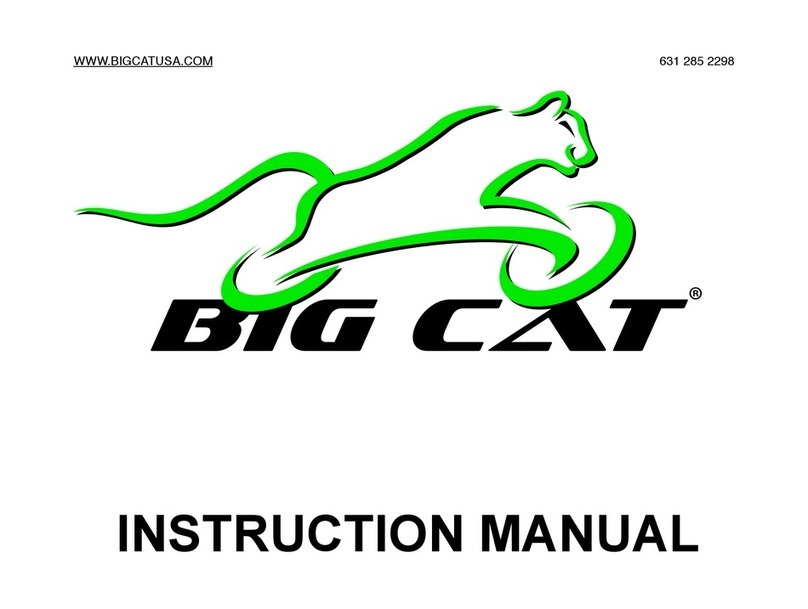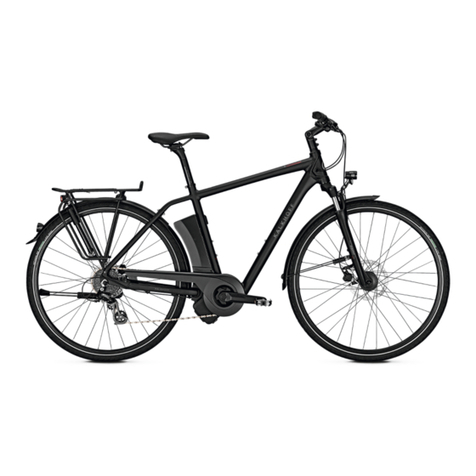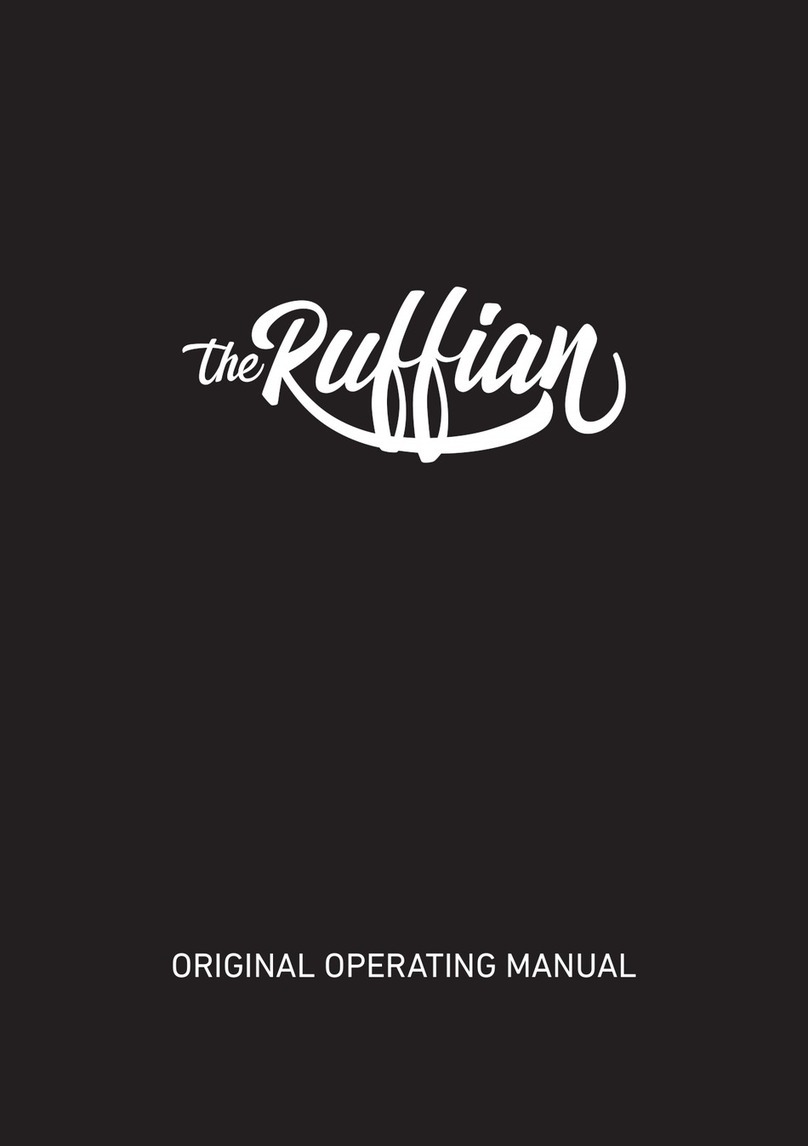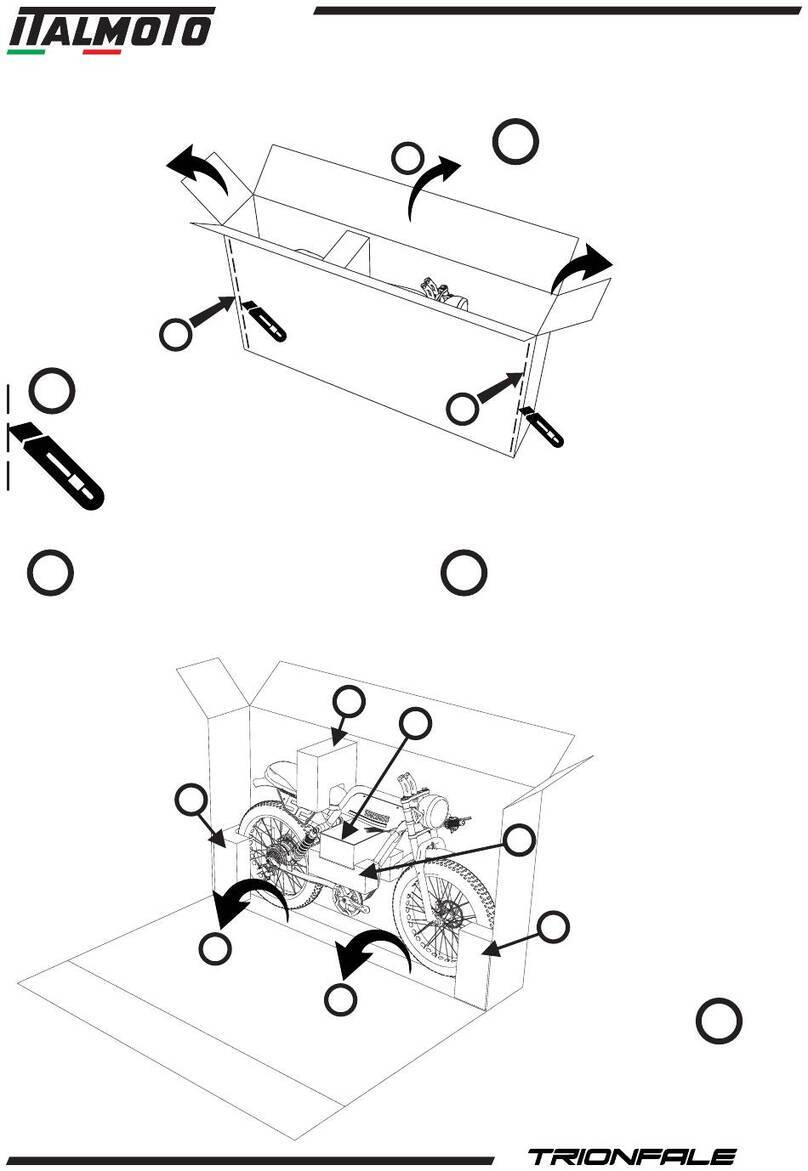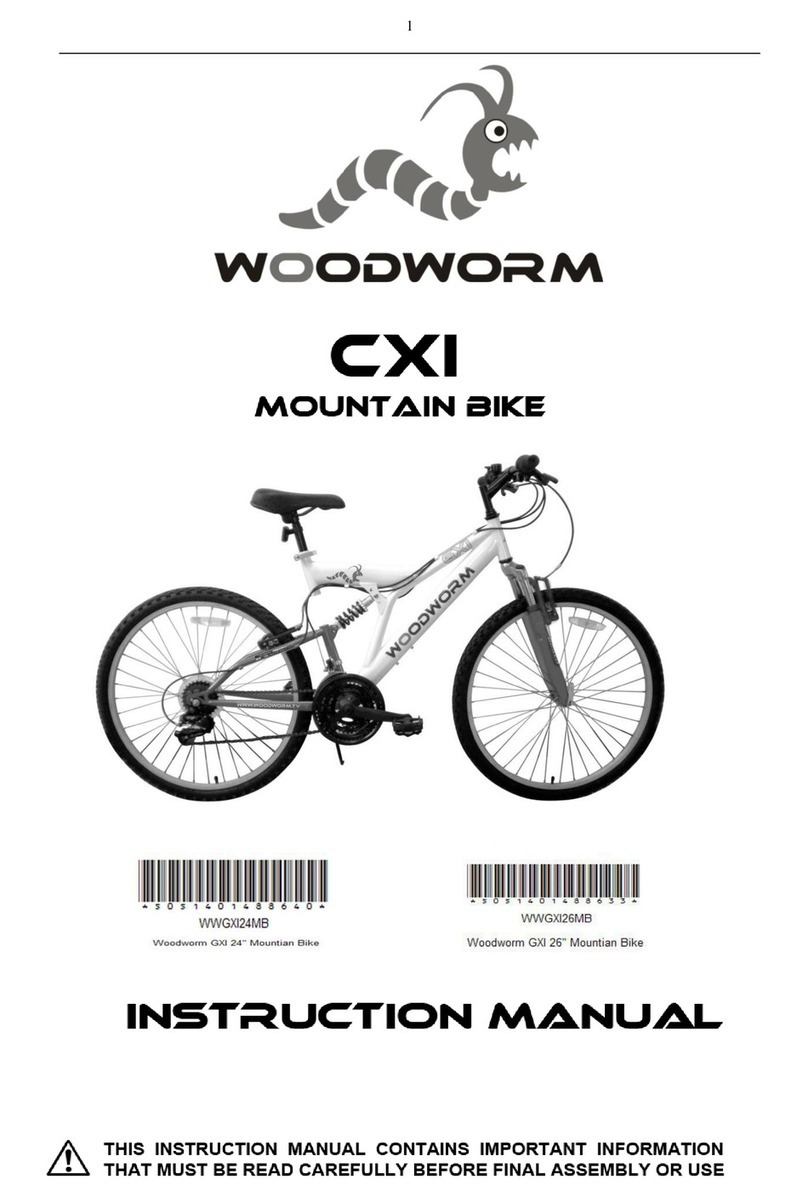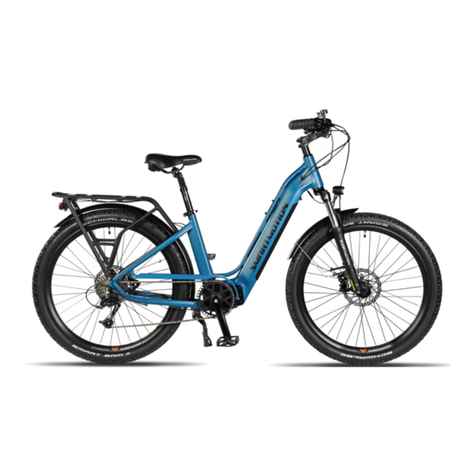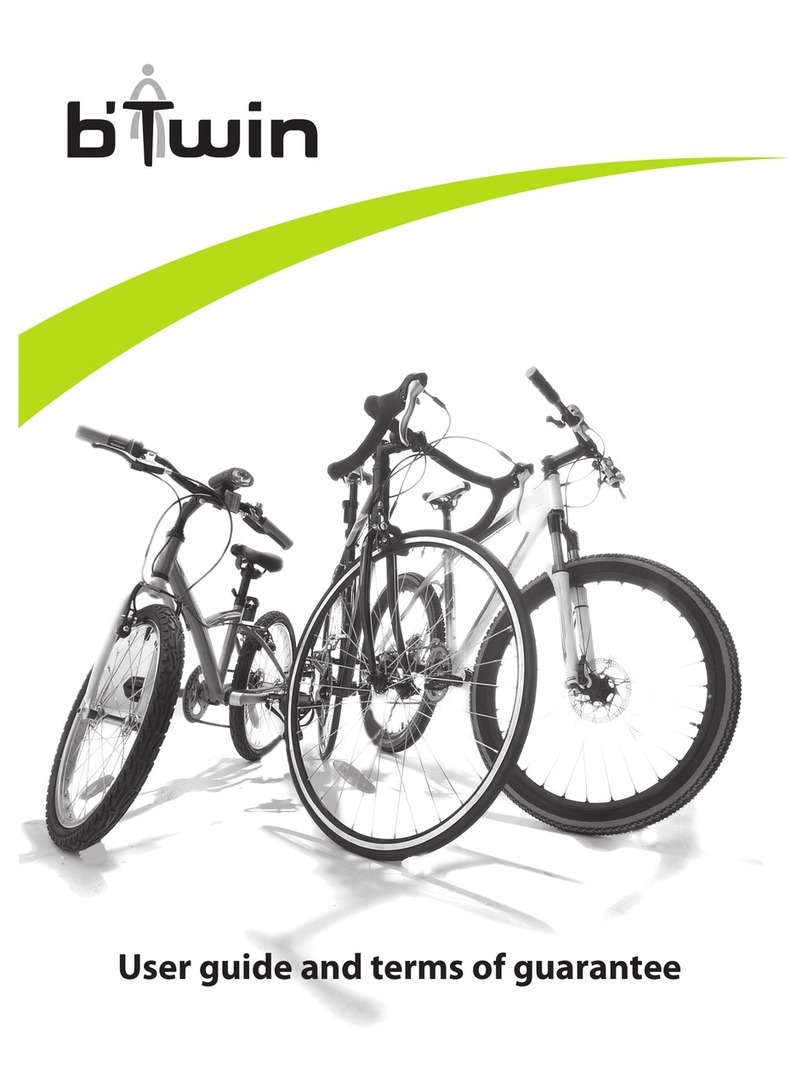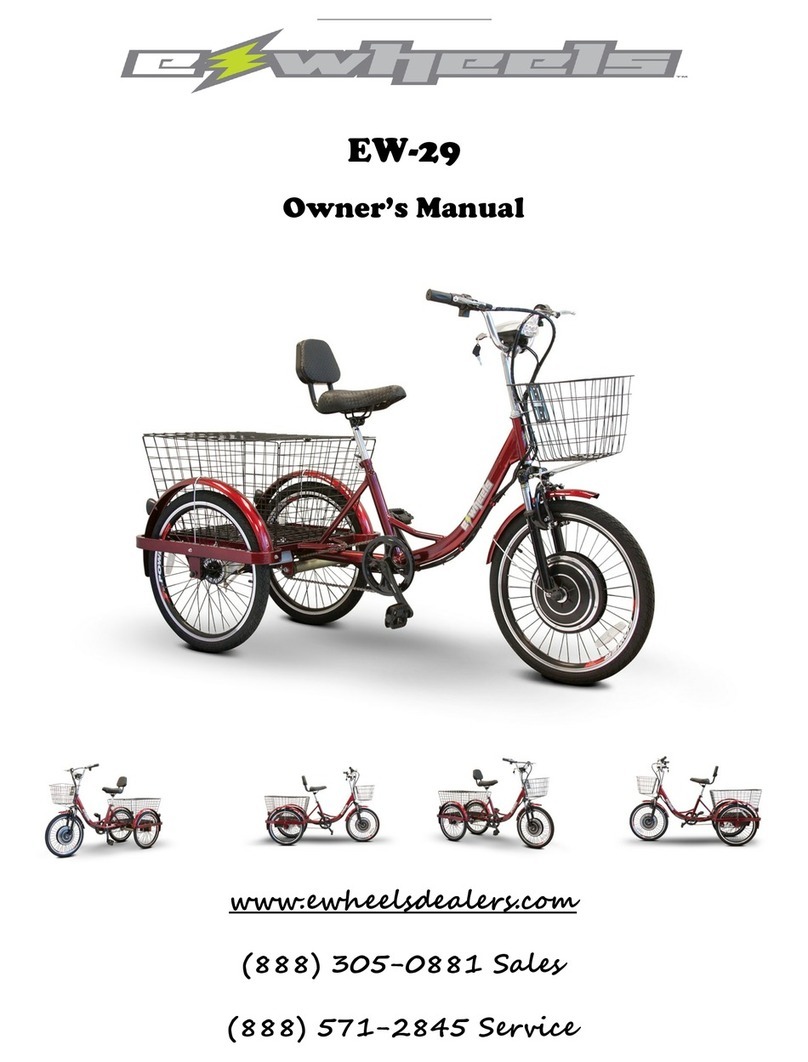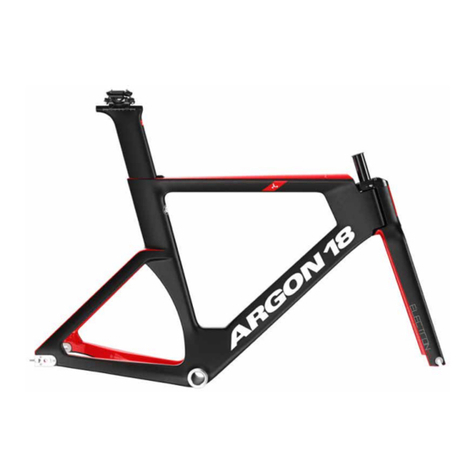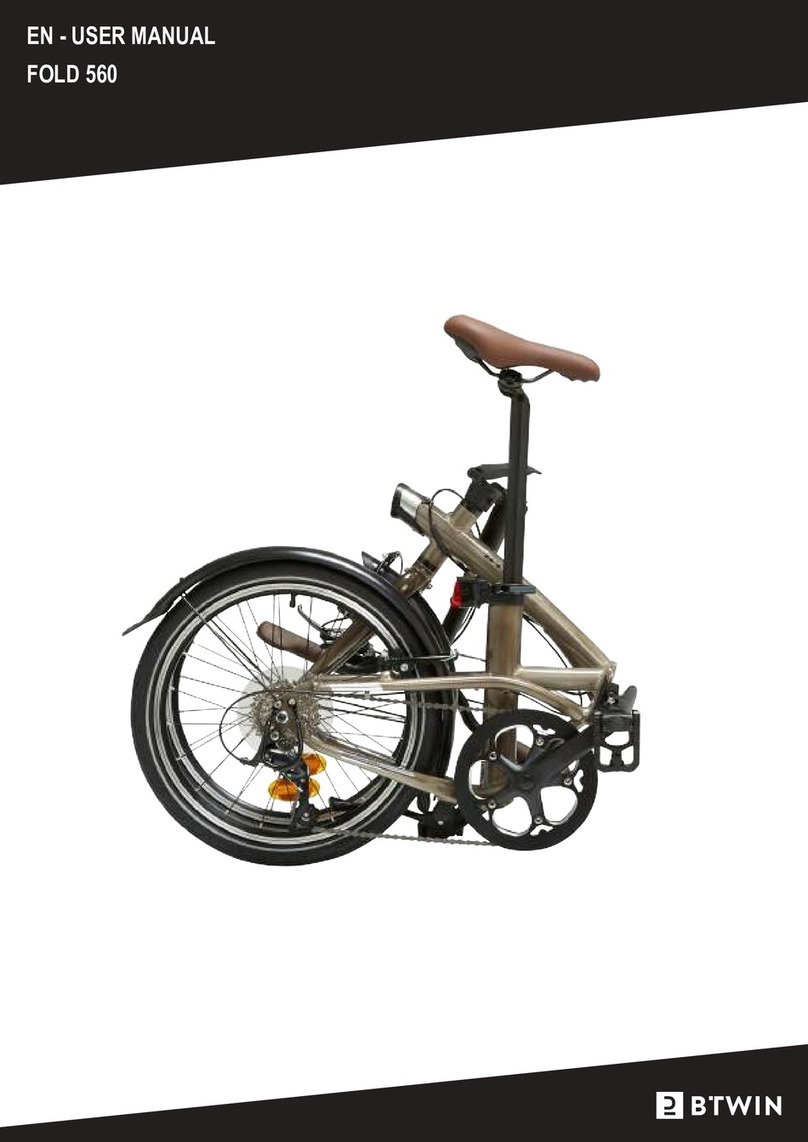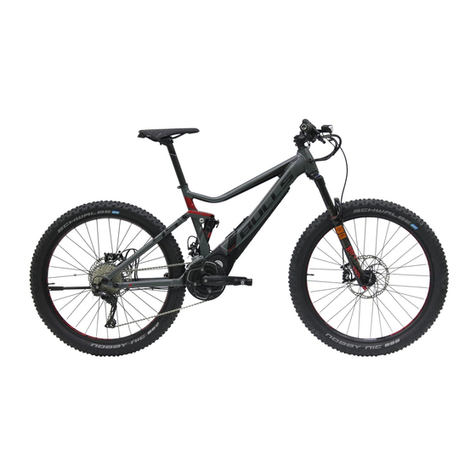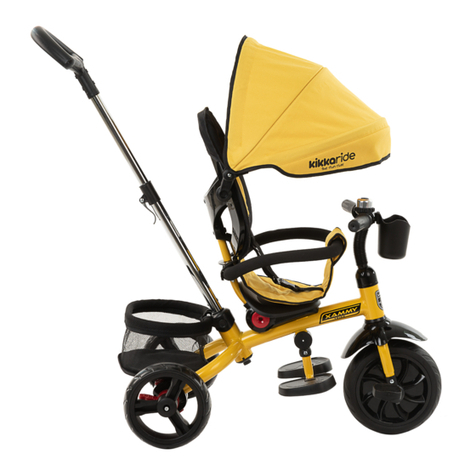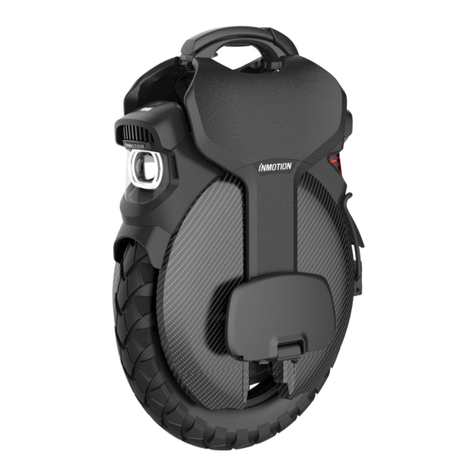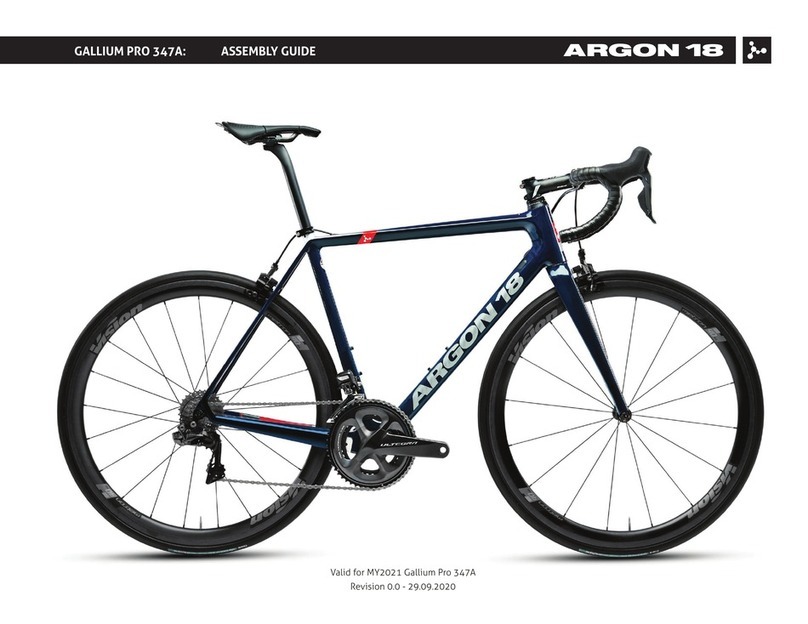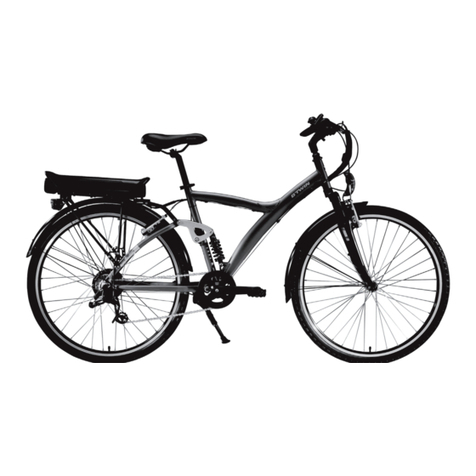Big cat Catrike Speed Series User manual

TM
Big Cat HPV. LLC
720 Business Park Blvd Ste 22
Winter Garden, Fl 34787
Owner Manual 2005


pg - 01
TM
Owner Manual 2005 / Road, Speed and Pocket

pg - 02
TM
Contents
03 Introduction
04 Safety and riding tips
06 Maintenance tips
07 Assembly instructions
14 Specifications
15 Limited Warranty

pg - 03
TM
Introduction
Thank you for purchasing a Catrike! You made the right decision by buying a fine quality product
that performs and that will bring you fun and good times for years to come.
Please take a moment to read through this document, especially the sections on safety and riding
tips. Youmayfind that the most comfortableplace to be while you’redoing this is sitting (stationary)
on your trike!
We hope you enjoy owning and riding your Catrike!
Paulo Camasmie
CEO & Designer
Big Cat HPV, LLC

pg - 04
TM
Safety and riding tips
Safety tips
Riding safely depends on many things, from proper equipment to alertness to your attitude on the road.Above all, use common
sense.
The ideal place to ride your Catrike is bicycle trails & paths. The Catrikes are probably the best choice in that setting. You
will enjoy the view, relax and socialize. You will have the most comfort, piece of mind and fun. If you elect, however, to ride
on streets, you will have to do it at your own risk and know that whether it is a regular bicycle, a recumbent or a tricycle you
have to be very careful. ÊBecause a trike is so low to the ground you have to be extra careful with cars and trucks. Therefore
you have to take a great care to make yourself visible. In part, you do this with equipment such as brightly colored clothing
and helmets, use of the safety flag that comes with every Catrike, and also with blinking lights and reflective stickers. But
you also have to ride in such a way that you engage the attention of motorists, making eye contact, signaling your intentions,
being courteous, smiling and waving. You use your voice to get attention. You also pay a lot of attention when riding in traffic
and you obey all traffic laws and rules of the road. The positive side is that recumbent tricycles are very much a novelty, and
once you make sure that you are being seen, you generally find that motorists leave you more room and respect when you’re
on our Catrikes than they do when you’re on upright bicycles. Nevertheless, always assume that they don’t see you.
Reflective and high-visibility gear is great (and we use it all the time), but it’s no substitute for lights when riding at night or in
low-light conditions. The new super-high-output LED rear lights are very effective. Any small headlight (those that look like
flashlights) may be enough to help oncoming motorists see you, but it’s not sufficient to actually light your way. If you’re going
to ride at night, spend the money and get a good headlight.
While it may seem silly to wear a helmet on a low-slung tricycle, you should always do so. It’s very hard to tip the trike over,
but it can happen. Also, if you have a close encounter of the worst kind with a car or stationary object, chances are you won’t
stay on the trike.Always wear a CPSC-approved cycling helmet when riding your Catrike. Abrightly colored helmet also helps
motorists see you.
You’re very low, and it’s possible for road grit to get whipped up by the wind or kicked up by passing cars and hit you in the
face. Thisisespeciallytrue in the spring in areas where sand is usedontheroads in winter. It’sa good idea to wear sunglasses
to protect your eyes. You may also want to wear gloves. It’s easy to reach the ground on your Catrike, and getting a palm
full of sand and ground glass is no fun.
We strongly recommend the use of a mirror. Don’t rely entirely on it. Turn and look before changing lanes or turning across
the line of traffic.
Riding along a line of parked cars presents a particular danger for those on low-slung bikes and trikes. Motorists have a habit
of opening their doors suddenly without looking behind them…and even if they do look, they’re concentrating on looking for
oncoming cars, not a low trike. When riding along a line of parked cars, look for occupants inside as you approach. If you
see someone sitting in the car, give them a bit of extra room.
Pedestrians, too, often aren’t looking where you are. Use caution when approaching crosswalks and use your bell, horn or
your voice to alert those who may be stepping into the street.
Your Catrike has a fixed seat for several good reasons, and one of these is that it keeps the center of gravity where it should
be for good handling. If you carry loaded panniers, avoid putting the weight too high and too far aft, or it can cause poor,
even unsafe, handling.

pg - 05
TM
Riding tips
If you don’t have experience with recumbent tricycles, you may find that for the first few rides you experience noticeable pedal
steer (pushing hard on the pedals makes the trike swerve) and brake steer (grabbing one brake harder than the other causes
the trike to swerve). These two phenomena become much less noticeable as you gain experience. Pedal steer is minimized
or eliminated by pedaling smoothly at a fairly high cadence, rather than mashing hard. Brake steer is minimized by braking
smoothly and evenly…if the trike lurches under braking you’re overdoing it (it’s like driving your car…you don’t stand on the
brakes every time you slow the car; rather, you learn to modulate the pressure so that the car does not lurch).
The smoothest, most enjoyable ride comes when you learn not to over control the trike. The steering is very responsive, and
does not require much input at all to make the trike change direction. The less you try to steer, the smoother the ride will be.
It’s possible to get the trike up onto two wheels, but this should be avoided. It puts a lot of stress on the components and can
cause loss of control. Bicycle wheels, hubs and tires are not designed for heavy lateral loads, and if you go up on two wheels
you’re asking them to do something they were never meant for. Your Catrike is wonderfully responsive and handles very well,
but it’s possible to overdo it. Use common sense. You’ll find that the trike stays more firmly planted when going around a corner
at speed if you lean to the inside of the turn.
The brakes on your Catrike are very powerful. It is quite possible to do a “stoppie” on the Catrike (lock the front
wheels and lift the rear wheel off the ground by jamming on the brakes). In extreme cases, you can hit the chain
rings on the ground and damage them. Use common sense. Don’t use maximum braking unless you really need
to. (At high enough speeds, the trike won’t lift the rear wheel…it will just skid. And at very low speeds, there isn’t
enough momentum to hit the chain rings on the ground.)
Brake Steering: Our frames are designed for a diminished brake steer effect. However keep in mind that the trike
is not a heavy vehicle such as a car. It does not have hydraulic, electronics or self correcting mechanisms either.
It is instead, a very light recreational vehicle with a mechanical steering linkage that carries a rider sometimes
over 8 times its weight. Therefore the weight & dynamics of the driver can exert total control over the capabilities
of the vehicle. It does demand that the rider develops proper riding skills, such as smooth pedaling, smooth
steering and smooth breaking and that it is always conscious when riding. The Catrike has front brakes only,
since in a breaking situation 90% of the weight is transferred to the front of the trike. The front brakes are also
independent, meaning that you can break the right wheel only, or the left wheel only. Therefore, especially in high
speedor down hill situations, it ismandatory that you pull bothbrakes at the same time andwith the same intensity.
If you elect however, to brake only with one brake, this could cause the trike to steer out of your path and cause
serious injury or death.
Make sure the boom clamp is tight enough, so the boom will not twist while you pedal. Just like a bicycle seat
post clamp, it is the rider responsibility to check for the boom clamp tightness. The boom clamp is designed for
a high pressure clamp action. It also included a plastic shim to be installed between the boom and the main frame
for zero gap and increased clamping action. Make sure the plastic shim is correctly placed and that the boom
clamp is tight enough to avoid the boom to spin inside the frame. If for any reason, you are unable to install or
tight the boom clamp enough, please don’t ride and contact your Catrike dealer or Big Cat HPV, LLC. Failure to
do so might cause the boom to twist and cause serious injury.

pg - 06
TM
Makeita habit to inspect your trike from time totime,especially
when new. Fasteners have a habit of working loose at first
and this can cause a safety hazard. Also, you’ll find that the
right front wheel tends to pick up debris from the edge of the
roadfasterthan the left front wheel, because it’srunning closer
to the curb. The Catrike comes with Kevlar-belted tires for
puncture resistance, but this does not mean they’re immune
to flats.
Keeping your trike clean will maximize its life. Wash it from
time to time, but avoid the use of pressure washers. They do
a great job of getting dirt out of tight spaces, but they do an
equally good job of driving lubricant out of where it needs to
be. It’s better to use a bucket of water, mild detergent and a
soft brush.
We recommend fitting fenders to the trike. This goes a long
way towards keeping it from getting dirty in the first place.
Many new owners tend to over-lube the chain. It should not
be dripping with lube. A properly lubricated chain looks dry
and clean, and while it may leave a bit of a mark on your hand
ifyougrab it, it should not be a gloppymess. Useyourfavorite
lube and follow the instructions.
Always keep your tires filled to the recommended pressure
(printedonthetiresidewall). Thetubesarenot entirely airtight,
and the tire will lose pressure over time. Trikes by nature will
scrubthe tires a bit, so theymay not last as long asthey would
on a bicycle. Overly aggressive riding will shorten tire life.
Your seat mesh will stretch a bit and settle in over time. It’s
not meant to be drum-tight…it’s meant to support you
comfortably. Pull the straps tight from time to time when the
trike is new…eventually the mesh and straps will settle into a
stable configuration that you’ll find is quite comfortable.
If you’ve purchased the optional headrest, we recommend
placing the pad so that it’s behind your neck, just under the
lower edge of the helmet, and in a position that lets you rest
your head on it if you need to but which doesn’t force you to
have your head on it all the time. The headrest is nice and
soft, but it does transmit road vibration. On the Speed, we find
that we can ride all day without using the headrest as long as
the road is flat, but as soon as we start climbing hills it’s nice
to have that support available. On the Road, many people
find that the headrest is not necessary at all.
If you’re adjusting the trike to fit another rider, make absolutely
certain that the chain is of the right length. In order to get the
maximum possible gear range, the Catrike drive train pushes
the derailleurs close to their maximum capacity. The chain
must be long enough to handle the big chain ring/big cog
combination…if it’s too short, it’s possible to severely damage
thedrive trainbyshifting intothisgear combinationandapplying
power. You can get away with a slack chain, but NEVER ride
with a chain that’s too short.
Improper toe can cause extremely rapid tire wear. Toe is set
bythe mechanic during installation of the tie rod. We’veheard
reports from the field of improperly set toe, with resulting
excessive tire wear. Don’t assume it’s been done right! Check
ityourself. Toeis checked bymeasuringthe distance between
the front tires at approximately axle height ahead of the axle,
then comparing this measurement with the distance between
the tires behind the axle. The difference should be no more
than 1/16 inch with the front narrower than the rear. See the
section on toe in the assembly instructions to learn more.
Maintenance tips

pg - 07
TM
Your Catrike should be fully assembled, tested and fine tuned
byyourCatrikedealer orlocalbike store.Herearetheassembly
instructions in order to show how this process is done.
Inside the box there are five separate items:
• The frame assemblage, tie rod, and all three wheels.
•A small box containing components.
•A small box containing all other parts.
•A safety flag.
The first step is to inventory the parts:
• Main frame with all the headsets and spindles in place.
- Two spindle/axle assemblies with brake calipers already
mounted
- The idler and chain tube pre-assembled and installed on
the frame.
- The quick-release boom clamp is also installed.
- The seat is already installed
• Two handle bar assemblies with shifters, shift cables, shift
cable housings, grips and brake levers installed.
• Two axles and axle nuts
• Grey plastic boom shim (6”x5.5”x.031” thick)
• Boom with bottom bracket (BB) installed
•Twofront wheels withtubes, tires and brake rotors installed.
• One rear wheel with cassette installed.
• Quick-release rear wheel skewer.
• One tie rod with rod-end bearings and jam nuts installed.
• One crank set.
• Front and rear derailleurs.
• Rear derailleur hanger with bolt zip tied to the drop out.
• Brake cables and two lengths of brake cable housing.
• Cable ferrules and cable ends.
• Three chains with PowerLink master links.
•Safety flag withflagmount(mount mightbealreadymounted
on frame)
Youwill se onthebottomof your trike yourframeserialnumber.
CS# for Speed
CTR# for Road
CTP# for Pocket
It is very common among Catrike owners on the net to identify
themselves with their names followed by their trike models
and serial numbers. Welcome to this nice group.
Other optional accessories such as a headrest or fenders may
also be in the box.
Tools required
To put your Catrike together, you’ll need:
• A set of metric Allen wrenches.
•A set of EnglishAllen wrenches.
• A small adjustable wrench. We
strongly recommend against the
useofplierstoholdandturnnuts.
Itonly serves tofrustrateyouand
destroy the nut.
• The axle bolt installation tools included with your Catrike.
Shouldyoulose or misplace these tools, anypieceofmetal
about 1/8” thick will do…the back of the blade of a table
knife will work, or even a house key, for example.All that’s
important is that it fit in BOTH slots in the bolt and be large
enough to grip with your hand.
•A bicycle chain tool.
• A small screwdriver (to adjust the derailleurs).
• A bicycle cable and housing cutter (ordinary wire snips
tend to flatten and mangle the end of the cable; you can
get by with a good sharp pair, but it’s much better to buy
the cable and housing cutter: you’ll use it often in the
future).
Also very good to have but not absolutely mandatory are:
•Anti-seize compound (available at any automotive store).
• RTV or silicon sealant is recommended instead of thread-
lock compound as the strong bond of thread-lock can
easily damage aluminum threads.
• Zip ties.
• Bicycle pedal wrench.
• “Fourth hand” tool (a cable stretcher…handy for holding
the cable while you make derailleur and brake
adjustments).
• A good bicycle maintenance book. Sharpie indelible
marker(to markthelocationoftheboomonceit’sadjusted
to fit you).
Assembly instructions

pg - 08
TM
! IMPORTANT NOTE !
The frame and many other parts of your Catrike are made of
aluminum.It isVERYeasytostripaluminum threads,especially
if steel fasteners are going into them. BE CAREFUL not to
cross-thread or over tighten any fastener!
TIP:An easy (albeit rough)
way to estimate the proper
tightness for aluminum
fasteners is to use two or
threefingers on the wrench,
no more. This limits the
amount of force you can
applyto the tool beforeyour
fingers slip off. Use two fingers for small fasteners, or three
for larger ones.
Because we have no control over how tightly you assemble
your Catrike it is extremely important for you to re-check all of
the threaded fasteners (pedals, axle bolts, and all other nuts
and bolts) on the trike after you’ve ridden it for a couple of
hours,just to make sureeverythingisstill tight. Periodic checks
during the riding season also are a good idea. Virtually all of
thetrouble reports we receiveare nothing more than fasteners
that have worked loose.
BEGIN ASSEMBLY
Install the rear wheel.
• Insert the derailleur hanger into its recess on the right
dropout and tighten the bolt.
Insert the quick release into the rear wheel, put the wheel into
the dropouts, tighten and close the quick release.
Install the front wheels.
•Attach the front wheels to their respective spindle/steering
arm assemblies. First you need to identify the left and
right spindle assemblies and the left and right wheels.
Look at the writing on the brake discs. At least one of them
will have a marking that says
“DIRECTION OF ROTATION.”
This will tell you which wheel it
is (just remember that the brake
disc goes on the inside of the
wheel). This photo shows the
right wheel.
Shown right (on the right) and
left (on the left) Catrike Speed
and Pocket spindles. Spindles
may also be called kingpin or
steering knuckles.
Shown, right Road spindle with
caliper mount and rod end
already installed. Also shown
headset(frombottomtotop) split
crown race (golden), lower
bearing, upper bearing, top
compression plug, dust cap, 1”
clamp and headset cap.
Unscrewthe axle bolts, remove them andthe retaining washer
from the end of the axle tube, and slide the axle tube out the
back of the spindle assembly.
DiscBrake installationandadjustment:Please seeSRAM/AVID
installation manual at:
http://www.sram.com/_media/techdocs/bbdb-mtn-160-install.pdf
Loosen the brake caliper
adjustment bolts. This will let
thecaliperfloatfreewhile you’re
mounting the wheel.
Now you can place the wheel in position, sliding the disc in
betweenthebrakepads. Place the wheel hub opening directly
over the axle, then slide the axle through the hub from behind
the spindle assembly (the bolt and its retaining ring go on
wheel…make sure you don’t slide the axle in backwards).
Place the cone-shaped retaining ring (flat side in) against the
hub, thread the axle bolt in and snugly hand-tighten it using
an appropriately sized piece of metal. A chain ring bolt tool
fitsperfectly… the back ofthe blade of a table knife also works
well.

pg - 09
TM
! IMPORTANT SAFETY NOTE !
These bolts hold the wheels on, so it’s VERY important that
they be kept secure. Check them from time to time. We
recommend using a small amount of RTV or silicone sealant
on the last few threads to keep the axle nut from vibrating
loose. As the RTV will resist vibration nuts installed in this
mannerwill not need to betightened excessively to keep them
in place. Sufficient torque can be applied using the provided
axle tool.
Next, adjust the calipers. One of the nice things about the
Avid disc brakes on your Catrike is that they are very easy to
adjust:
• If the caliper mounting bolts have been tightened, loosen
them.
•Adjust the brake pads. Use the knurled plastic adjuster
knobs on either side of the caliper until the pads are firmly
contacting the rotor. First screw the larger knob (the one
closest to the wheel hub) in until the disc is offset slightly
away from the wheel hub. Then screw the smaller knob in
until the rotor is held tightly.
• Tighten the caliper mounting bolts.
• Back off the pad adjuster knobs until the disc spins freely
and without noise…about 1/2 turn each.
The wheel should now spin freely. If you hear any noise, back
off the adjusting knobs a bit more until it goes away.
Install the spindles with headsets into the head tubes.
Alloy headset cups already
pressfitinsidetheheadtubes
Insert the spindle from the
bottom of the head tube with
the crown race and lower
bearing on the bottom.
Assemble all other parts on
the top of the head tube.
*Road spindles shown in
pictures.
Finish the assembly off with
the 1” clamp provided with an
M6x1 stainless socket head
screw.
Spindle assembly is complete. The
installationoftheheadset is identical
to a bicycle. The only difference is
that the 1” clamp has the assembly
function of a stem. Pre-load the
bearing by tightening. The bearing
load should be set the same as with
a bicycle.
• On the Speed and the Pocket, install the handle bar onto
the spindle in place of the 1” clamp. Replace the head set
top cap and tighten it down. For the position of the handle
bars, the handgrips should be behind the spindles and
outboard of them, between the spindle and the tire. You’ll
know you have it right if the shifters point forward and the
brakelevers are in linewith the centerline of the trike. The
position of the grips can be adjusted in or out if you wish,
but make sure you realign the shifters and brake levers.
Handle bar assembly for the Road:
Assemble the parts on the steering shaft in the order shown
on the picture on the right. From bottom up:
01) 1-1/8” steering shaft clamp
02) Crown race split (golden)
03) lower bearing
04) shaft
05)headtubethroughtheframe
06) upper bearing
07) top compression ring
08) headset dust cap
09) stem
10) headset cap
11) bolt through the star nut
inside the shaft
Pre-loadthebearings the same
way you would do on a bicycle
stem installation. Pre-load the
bearing, then tighten the stem
bolts and finish torquing the
headset cap.
Here you see the right
and left spindle, the tie
rods, the steering
mechanismandthepre-
assembled handle bar.
• Install the handlebars on the steering stem.
Next comes the tie rod.
• For the Speed and Pocket:
The tie rod goes under the seat side rails and over the
main frame tube, and bolts in place on top of the small
plates on the spindle assemblies. Note that one of the
bearings is reverse-
threaded. This is
important if you
disassemble the tie rod,
since using the wrong
jam nut or attempting to
threadthe wrong bearing
into the rod will strip the
threads.

pg - 10
TM
Take the tie rod and turn the jam nuts all the way out towards
the rod-end bearings (if they aren’t already) then screw the
rod-end bearings in as far as they’ll go.
Bolt each rod end bearing to its spindle assembly, placing the
ball of the rod-end bearing on top of the spindle plate. The
bolt goes in from the top, and the nut goes on underneath the
plate. Tighten everything snugly.
•For the Road:
The Road tie rods have right
and left rod end bearings, so
thatyou can micro-adjust them
forpropertoein. Youcanadjust
them by unlocking the jam nut
and spinning the tie rods by hand.
Thread each tie rod end in
half way before mounting it.
This will give you the most
“travel” when adjusting toe
later. Attach the rod end
bearings to the handle bars.
Next, attach the rod end
bearings to each spindle.
TIP: This is one of the few places on the Catrike where a steel
bolt is threaded into a steel nut. The caution about the ease
of stripping threads does not apply here.
! IMPORTANT SAFETY NOTE !
The tie rod bolts should be kept tightened securely. If they get
loose,the steering will get sloppyand the wheels may shimmy
undercertain circumstances. If the boltsfall out, loss ofcontrol
could result. Check them from time to time!
Install the brake cables.
•This is doneby threading the cable through the brakelever
and fitting the small metal cylinder on the end into the
recess in the lever. Screw the barrel adjusters on the
bottom of the levers almost all of the way in (they’ll be
used later to take up slack during brake adjustment).
The procedure for the left
and right brake is the same.
Slide the brake cable
housingon. Youshouldhave
eight cable ferrules. Four
are for the brake cable
housings. Thread the cable
through a ferrule, then
through the housing, then
through another ferrule.
Thread the end of the cable through the fittings in the brake
actuating arm. The ferrule fits under the rubber boot. Loosen
the cable clamp bolt, put the cable under the clamp plate, pull
it taut and retighten the bolt. Using a bicycle cable cutter
(preferred)or a SHARP pair ofwire cutters cut the brake cable
so that a few inches extend beyond the clamp bolt.
! IMPORTANT SAFETY NOTE !
The end of the cut cable MUST be sealed, or it will fray and
cause a serious safety hazard. Those wires are sharp! Crimp
on one of the included cable ends.
TIP: If you run out of cable ends, and can’t get to a bike shop
for more, you can use a drop of cyanoacrylate glue (Krazy
Glue), some epoxy or a blob of solder to seal the cable ends.
Adjust the brakes
•First pull hard onboth brake levers toseat the cables. Turn
the barrel adjusters out until the levers do not bottom out
when the brakes are applied fully. If you cannot set the
brakes using the barrel adjusters, you’ll have to take up
more slack in the cable by loosening the clamp bolt and
pulling the cable tighter.
Screw in the lock nuts on the adjusters.
If the brake makes noise or drags, adjust the caliper position
and/or the brake pad relief using the caliper mounting bolts
and pad adjusting knobs.
Install the boom on the main frame tube.
• Be sure to place the plastic sleeve between the main frame
tube and the boom. The plastic sleeve referred to is 6” x
5-1/2” polymer sheet. It is installed with the 6” dimension
(the long side) running forward and backward along the
boom. If you install it with the long side around the boom
it will cause to boom to be much too tight assuming you
manage to force it into the frame.
When you install the boom,
makesure the plastic sleeve is
properly placed, flush with the
end of the frame under the
collar. Once the boom is in
place,tightenthequickrelease
only enough to keep it from
sliding: you’ll be adjusting it
later.

pg - 11
TM
! IMPORTANT SAFETY NOTE !
Never lubricate or wax the part of the boom that sits inside the
frame. This can cause it to slip. Once it’s adjusted, make sure
it’s tightened enough to avoid slipping under power.
CAUTION: Make sure the boom clamp is tight enough, so the
boom will not twist while you pedal. Just like a bicycle seat
post clamp, it is the rider responsibility to check for the boom
clamp tightness. The boom clamp is designed for a high
pressure clamp action. It also included a plastic shim to be
installed between the boom and the main frame for zero gap
and increased clamping action. Make sure the plastic shim is
correctly placed and that the boom clamp is tight enough to
avoid the boom to spin inside the frame. If for any reason,
you are unable to install or tight the boom clamp enough,
please don’t ride and contact your Catrike dealer or Big Cat
HPV, LLC. Failure to do so might cause the boom to twist and
cause serious injury.
Install the derailleurs.
• Install the front derailleur on the derailleur post. Line up
the cage with the chainrings and position the curve of the
derailleur cage so that it clears the big chain ring by about
2mm (1/8”). There should be a small plastic guide taped
to the cage to assist you in this.
• Install the rear derailleur by bolting it in place.
Run the shifter cables.
• Cable guides have been provided on the boom clamp and
rear chain stay. The actual routing is not important, as
long as sharp bends are avoided. The recommended
routing for the left side (front derailleur cable) is to run the
cable between the seat brace and the seat mesh (not yet
installed) from behind before running it forward. Likewise,
run the rear derailleur cable between the seat brace and
the mesh from the front.
• Installation of the cables at the derailleurs is similar to the
installationon the brakes. Put a ferrule ontheend of each
cable housing. Thread the cables into the derailleurs, pull
them taut, clamp them down, trim and seal the ends.
Before you clamp the rear derailleur cable in place, screw
the barrel adjuster on the derailleur in as far as it will go,
then back it off 1 to 1-1/2 full turns. Note that there is no
adjuster on the front derailleur.
Install your preferred pedals.
• We recommend that you use clipless pedals. They’re not
only safer; they’re far more convenient and comfortable
than using plain pedals.
! IMPORTANT NOTE !
The left pedal is reverse threaded. Make sure you don’t try to
install the pedals backwards, or you might strip the crank
threads. Your pedals will be clearly marked so you can tell
which is which.
TIP: Usinganti-seizecompound on the pedal threads willmake
future disassembly much easier and will help prevent damage
to the threads in the crank arms.
Install the seat mesh.
• Lay the mesh out to get your bearings. The upper edge
of the seat has two straps
and buckles. The sewn-
in sleeve for the flag goes
onthe left sideoftheseat.
Placetheseat mesh over
the frame and thread the
straps into the buckles.
Note that there’s a right
way and a wrong way to
thread the straps into the
buckles. It’s easy to tell
if you’ve done it wrong: it
won’t hold tension.
First thread the straps on loosely and position the seat mesh
so that it is square on the frame, with the cutouts for the lower
seat support tubes positioned properly. Tighten all of the
buckles as tight as you can with your hands. You will find that
whenyousit on the seat, the meshwillloosenabitandbuckles
will slip or the mesh will shift a bit.
This is normal. Adjust the position and re-tighten as needed.
The seat mesh will stretch a bit at first, requiring re-tightening,
but will soon break in and stop moving. The comfort of the
Catrike seat comes from the mesh cradling and supporting
your body, so it’s okay if the buckles slip a bit as they find their
preferred tension. Trying to keep them drum-tight is not only
futile, it’s not as comfortable as letting them support your body
fully.
It is normal to have a small wrinkle on the seat tubes at the
base of the seat back.

pg - 12
TM
Set the boom length.
• Sit on the trike, wearing shoes like those you’ll have on
when riding, and adjust the boom length. This is done by
loosening the boom release enough to allow the boom to
move,then putting your instep on one pedal and extending
your leg fully (the boom will rotate…just move it back to
vertical with your hand). You should be able to lock your
knee, but not have to lock your knee. You can fine-tune
the position later. Re-tighten the boom release (or pinch
bolts) enough to keep the boom from slipping.
Humans are capable of producing some incredible power for
veryshort periods of timewhen accelerating from a dead stop.
If your boom is not clamped tightly enough, it will rotate and
slip forward.
•UsingthePowerLinks,assemblethethreeseparatelengths
of chain and install it. The power side (upper run) goes
under the idler, between the main cross member and the
tie rod, and over the top of the chainrings. The return side
(lower run) goes through the chain tube.
Note the chain routing above there are two chain guide tubes
withthe top tube running above the crossmember (drive ) and
bottomguide tube (return) runningbeneath the cross member.
The drivepart of chain runsunderneath the black guide pulley
and over the top of the chain ring.
TIPS: It’seasier to thread the chain if you immobilize the crank.
This can get messy! Protectyourworksurfaceandkeeppaper
towels handy. It’s easy to thread the chain through the rear
derailleur cage incorrectly. Make sure the chain runs cleanly
through it, and not over the retaining tabs.
Adjust the chain length. To do this, shift onto the largest cog
on the rear and the largest chain ring in the front. Pull the
chain taut, so that the rear derailleur cage is fully extended.
Then add two links. That will be close to the ideal length for
the chain. Use the included PowerLink to hold the chain
together.
If your Catrike will be used by more than one person, feel free
tousetwo PowerLinks so that the chain canbeeasilyadjusted
for other riders: simply set the trike up for the shorter rider,
then insert a piece of chain long enough to accommodate the
taller rider. If this short piece of chain is between two
PowerLinks, adjusting the trike should take only a couple of
minutes. It’s a good idea to mark the boom for both length and
orientation for each rider using a Sharpie marker, so that the
setting can be repeated easily.
Just to be clear on what we mean by “two links,” check the
photo. Don’t forget that the PowerLink counts as one link.
There’s a trick to opening a
PowerLink that seems to
elude many people. First
hold the link between your
thumb and forefinger, and
push the plates together
(towards one another). Then slide them in opposite directions,
as if you were snapping your fingers. Opening a PowerLink
should be easy…if you find yourself reaching for a pair of
pliers; you’re not doing it correctly.
TIP: It’s easier to work
ona chain under tension
if you create a loop of
slackandholditinplace
with a stiff, bent wire,
madefrom an old spoke
or wire coat hanger.
Adjust the derailleurs.
• Your Catrike should have shipped with information sheets
for both the front and rear derailleurs that describe this
process. Itwillalsobedescribedinanybicyclemaintenance
book.
Air the tires.
• Fill the tires to the recommended pressure (you can find
this on the sidewall of the tire).
Adjust the toe.
•Any vehicle with left and right wheels has a setting called
“toe.” This refers to the extent to which the front wheels
point towards one another. Toe in means that the front
edges of the wheels point inward slightly. Toe out means
they point outward slightly.
The purpose of toe is to keep the steering nice and tight. All
bearings and linkages inevitably have a little slop in them. By
applying a bit of force to the entire system, it’s possible to
remove that slop. But too much toe and you cause the tires
to scrub because they’re pointing far off the line of travel. This
causes premature tire wear and increased rolling resistance.
What you’re looking for is just a little bit of toe.
Toe is checked by measuring the distance between the front
wheels at axle height ahead of the axles, then comparing it to
the distance between the wheels at axle height behind the
axles. Thedifferenceshouldbeonly1/16”. Itcanbe measured
with a tape measure. Be sure to measure between the same
points (e.g. inner surfaces of the front tires, centerline of tires,
etc.) on both front and back.

pg - 13
TM
The simplest method we’ve found is to take a locking steel
tape measure, hold the tape just above the boom, place the
tape measure housing firmly against the wheel rim and extend
the tape until the end is firmly against the opposite rim. Take
careful note of the measurement.
Now do the same for the back of the wheel, running the tape
justabovetheseat. Therear measurement should be no more
than 1/16” greater than the front measurement. It’s very
important to get this right…if you have a quarter inch of toe
your tires will wear out VERY quickly and your trike will handle
oddly.
Sharp-eyed readers will note that if you use this method you
won’t actually be measuring points on the wheel that are 180
degrees apart. This is true…the boom and seat tubes get in
theway of takingmeasurementsthatare actually ataxleheight.
However, the difference between the measurement you get
and the true measurement is very small.
Setting toe on the Road model:
To set toe-in first have someone sitting on the trike. Adjust the
handle bars so that they are exactly parallel to the cross
member. Then set one front wheel so that it is exactly parallel
to the main frame. To determine this measure from the side
wall of the rim to the main frame both from the rear and front
ofthe rim; try todo both measurements fromthe same relative
height on the rim. Set the remaining wheel exactly parallel to
the first wheel. (See above) the distance measured between
the wheels should be the same when measured between the
front and rear of the opposing rims at the same relative height.
Alternatively one could set the toe-in to be 1/16” in. You can
dothat by completing the stepsabove to set it up parallel,then
turning the tie rod on each side a ¼ of a revolution out, so that
the front tips of the wheels will move in. The heavier the rider
is the more that is desired.
To set toe on the Speed and Pocket models:
To adjust the toe, simply loosen the rod end jam nuts rotate
the tie rod by rolling it between your fingers. The rod end
bearings are threaded in opposite directions, so rolling it one
way will make the rod longer (more toe in) and rolling it the
other way will make the rod shorter (toe out). The direction in
which the rod rotates depends on which way it was installed,
and is not important. The adjustment is sensitive: a quarter-
turn is about all that’s needed to get from zero toe to correct
toe. When you have the toe set correctly, use an adjustable
wrenchto tightenthejam nutsagainsttheends ofthealuminum
tierodtube. Werecommendtheuse of thread-lock compound
on the tie rod end threads to keep the jam nuts from vibrating
loose.
TIP: We hear a lot of reports from the field of improperly set
toe, with resulting excessive tire wear. Don’t assume it’s been
done right! Check it yourself.
Attach the flag.
• Your Catrike comes with a flag mount. Using the M5x16
socket head cap screw provided, attach it to the rear threaded
hole of the left drop out. Place the flag in the mount and use
a zip tie to secure it.
Install, if desired, your water bottle
mount (not provided) with the
M5x.8mmscrewsincludedwithyour
bottle
• You’re done! Put on your helmet and go have some fun!
! IMPORTANT NOTE !
It is normal for cables and assembled parts to settle and “bed
in” during the first several days of riding. It is important to go
over the trike carefully during this break-in period and adjust
anythingthat’sloosenedup.Thatmeansallfasteners,especially
the axle bolts and the tie rod nuts and bolts.

pg - 14
TM
2005 Catrike Speed
• Weight 12,73kg 29lb.
•Aluminum Space Frame 6061-T6
• Powder Coat (Red, Graphite)
• Wheel Base 990mm (39")
• Wheel Track 698mm (27.5")
• Total Width 774mm (30.5")
• Seat Height 165mm (6.5")
• SeatAngle 33 Degrees From Horizontal
• Bottom Bracket 381mm (15")
• Wheels Front 16" (349mm)
• Wheels Rear 20" (451mm)
• Turning Circle 13 Feet
ÊÊ (OutsideAxle To OutsideAxle)
• Speeds 27
• Turning Radius 84 Inches
• Gear Inch Range 17" To 98"
*Pedals Not Included
Fit & Ergonomics
• Weight Limit 275lb.
• Seat Width 14"
• X-Seam 39 To 46"
• (Option Extra Long Boom Up To 53")
Components
• Triple Crankset 30-42-52t
• Hollow Bottom Bracket
• Shimano Triple Front Derailleur
• Rear Derailleur Sram X9
•Avid Mechanical 7 Disc Brakes
• Sram X9. 1:1 Grip Shifters
• Cassete Sram, 11-26, 9-Speed
• Sram Pc-59 Chain
• Schwalbe Stelvio 120 Psi
• Racing Tire
• Safety Flag Included
• Suspended Neck Rest Included Standard
*Pedals Not Included
Finish
• ColorsAvailable: Graphite Or Black
• Seat Color: Black
2005 Catrike Road
• Weight 33lb. (15kg.).
•Aluminum Space Frame 6061-T6
• Powder Coat (Red OrÊ Blue)
• Wheel Base 965mm (38")
• Wheel Track 723mm (28.5")
• Total Width 800mm (31.5")
• Seat Height 228mm (9")
• SeatAngle 45 Degrees From Horizontal
• Bottom Bracket 355mm (14")
• Wheels Front/Rear 20" (406mm)
• Turning Circle 14 Feet (OutsideAxle To
OutsideAxle)
• Speeds 27
• Turning Radius 84 Inches
• Gear Inch Range 17" To 98"
• Rider Weight Limit 39" To 46"
Fit & Ergonomics
• Weight Limit 300lb.
• Seat Width 14"
• X-Seam 39 To 46"
• (Option Extra Long Boom Up To 53")
Components
• Triple Crankset 30-42-52t
• Shimano Triple Front Derailleur
• Hollow Bottom Bracket
• Sram X7 1:1 Grip Shifters
•Avid 5 Disc Brakes
• Sram 11-34 9sp. Cassette
• Sram X7 Rear Derailleur
• Sram Pc-59 Chain
• 406 Tires
• Safety Flag Included
*PedalsAnd Rack Not Included
*Welded Mirror Mounts Not Included
*SuggestedMirrorMountOnTopOfTheGrip
Shifters
Finish
•ColorsAvailable:Yellow,Red, Blue OrBlack
• Seat Color: Black
• Head Rest & Rear Rack (Option)
2005 Catrike Pocket
• 355 WheelsAll Around (18")
• Track 27.5" Total Width 30.5"
• Tig Welded Aluminum Space Frame
• Weight 27 Pounds
• Heat TreatedAdjustable Boom
• Catrike Quick Release Boom Clamp
• Seat WithAdjustable Straps
• Grip Shifters
• Sram CassetteÊ
• Sram 9 Speed Pc59 Chain With
Master Link
• Double Crankset
• Hollow Bottom Bracket
•Avid Mechanical 5 Disc Brakes
• Brake Levers
• Cnc HollowAlloy Axles
• Cnc Pulley
• 20mm Catrike Downhill Front HubsAnd
Rear Hub With Cartridge Koyo Bearings
• Igus Rod End Bearings
• Schwalbe Marathon 355 Tires
• Wheel Base 37"
• Seat Height 8"
• Turning Circle 13' 9"
• Turning Radius 82.5"
• 45 Degrees Upright Seat
• Weight Limit: 275 Lb.
• Msrp Us$1,750 (Plus Shipping)
• Msrp Canada $2,350 (Cad)
• *Pedals Not Included
ColorsAvailable: Yellow, Red, Blue Or Black
*Drive Train & Shifters Subject To Change
UponAvailability. Please, Consult Dealer.
Fit & Ergonomics
• Seat Width 14"
• X-Seam 39 To 46"
• (Option Extra Long Boom Up To 53")
Specifications

pg - 15
TM
Big Cat HPV, LLC warrants Catrike tricycle frames and steering
components against defects in materials or manufacturing for the life
ofthe tricycle, whileowned bythe original retailpurchaser.The limited
lifetime warranty on the frame and steering components does not
apply to the paint/finish; this is covered under the limited 1-year
warranty. Warranty coverage on Catrike proprietary components
(excluding tires, tubes and cables) extends for one year while owned
by the original retail purchaser. Warranty coverage of non-proprietary
components will be covered by the warranty stated by their original
manufacturers.
Warranty coverage is conditioned upon the tricycle being assembled
and adjusted correctly, being operated under normal conditions and
use, and being properly maintained. Proof of purchase is required
for any claims made under this warranty. The warranty is valid for the
original purchaser only and is non-transferable.
This warranty does not cover
Normal wear and tear.
Any damage, failure or loss caused by accident, misuse, neglect,
abuse,theft, orfailure to follow instructions or warnings in the owner’s
manual.
Anydamage, failure or loss caused by use of tricycles for stunt riding,
ramp jumping, acrobatics or other similar activities, or in any other
manner for which they were not designed. Bending of frames, forks,
handlebars, seat posts or wheel rims can be a sign of misuse or
abuse.
Anydamage,failureorlosscausedbytheuseoftricycles,notintended
for such use as, power driven vehicles.
The original owner shall pay all labor charges connected with the
repair or replacement of all parts. Under no circumstances does this
limited warranty include the cost of shipment or transportation to or
from an authorized Catrike dealer or Big Cat HPV.
Useful product life cycle
EveryCatrike tricycle and frameset has a useful life cycle.This useful
lifecycleisnotthesameasthewarrantyperiod.The warranty identifies
the period of time that Big Cat HPV will replace the product if this
becomes necessary. When Big Cat HPV provides a lifetime warranty,
this does not guarantee that the product will last forever. The length
of the useful life cycle will vary depending on the riding conditions
and care the trike receives. Competition, jumping, downhill racing,
trick riding (e.g. riding on two wheels, wheelstands), trial riding, riding
in severe conditions or climates, riding with extremely heavy loads
or any other non-standard use can substantially shorten the useful
product life cycle of a Catrike tricycle or frame set. Any one or a
combinationof these conditions may result in anunpredictable failure
of a Catrike tricycle or frame set that would not be covered by this
warranty. All Catrike tricycles and frame sets should be periodically
checked by an authorized Catrike dealer for indications of potential
failures including cracks, corrosion, dents, deformation, paint peeling
and any other indications of potential problems, inappropriate use or
abuse. These are important safety checks and very important to help
prevent accidents, bodily injury to the rider and shortened useful
product life cycle of a Catrike tricycle frameset.
Crash Replacement Program
If your Catrike tricycle or frameset ever fails in such a manner that
the warranty is denied, you are still eligible for Catrike's crash
replacement program. This program is intended to provide for a low
cost frame replacement when a frame failure is determined to be
caused by accident, crash, abuse or any other non-standard use.
Please see your Catrike dealer for details. This crash replacement
programis available to the originalowner forthe lifetime of the tricycle
or frame set. Your proof of purchase will be required.
Limitations
BigCat HPV reserves the right to makesole determination of whether
anyfailureor damage claimedunder warranty wascausedby material
ormanufacturing defect. Proofofpurchase from anauthorized Catrike
dealeris requiredfor any limited warranty replacement/repairor crash
replacement program.
Theforegoingwarranties are inlieu of and excludeall other warranties
notexpresslyset forth herein,whether express orimpliedby operation
of law or otherwise, including but not limited to any warranties of
merchantability for a particular purpose.
BigCat HPV shall in no event beliable for incidental or consequential
losses, damages or expenses in connection with its tricycle products.
BigCatHPV'sliabilityhereunderisexpressly limited to the replacement
of goods not complying with this warranty.
Some states do not permit the exclusion or limitation of implied
warranties or consequential damages, so the preceding limitations
and exclusions may not apply to you.
Procedures
Warranty service will be performed by Big Cat HPV or an authorized
Catrike dealer. Proof of purchase must be provided. Transportation
to and from the authorized Catrike dealer is the responsibility of the
purchaser.
Big Cat HPV will have the option of either repair or replacement at
nocharge for anydefective product, orrepayment of anamount equal
to the purchase price of the product.
In the event Big Cat HPV elects to replace a defective frame, a new
frame of equal or greater value will be provided. The new frame may
not be the exact model purchased. Big Cat HPV is not responsible
for dealer labor charges for component changeovers when a frame
is replaced after one year from the date of original retail purchase.
If you elect to repair a defective product yourself or use the services
of someone other than a Catrike authorized dealer, or if you use a
replacement part not supplied by Big Cat HPV, Big Cat HPV will not
be liable for any damage, failure or loss caused by the use of such
unauthorized service or parts.
IF YOU HAVE A PROBLEM
Contact yourAuthorized Catrike Dealer. Proof of purchase required.
Or contact Big Cat HPV at
Big Cat HPV, LLC
720 Business Park Blvd, Suite 22
Winter Garden, FL 34787
USA
Phone: (407) 905-0626
Fax: (407) 905-0820
http://www.catrike.com
This warranty gives you specific legal rights and you may also have
other rights which may vary from state to state.
Catrike Limited Warranty


TM
Big Cat HPV. LLC
720 Business Park Blvd Ste 22
Winter Garden, Fl 34787
This manual suits for next models
2
Table of contents
Other Big cat Bicycle manuals

